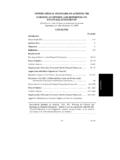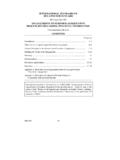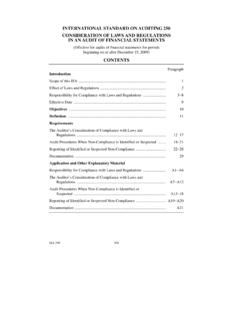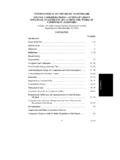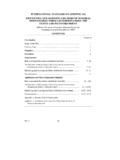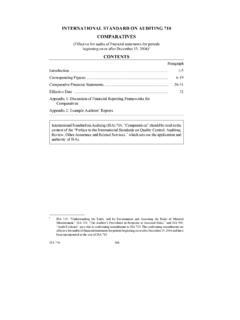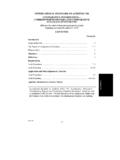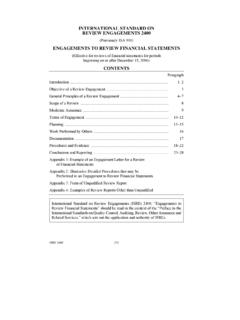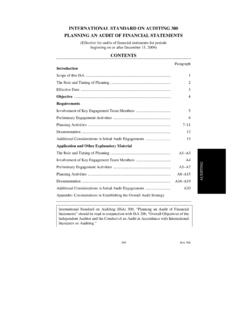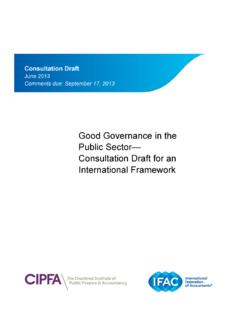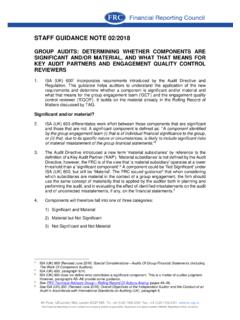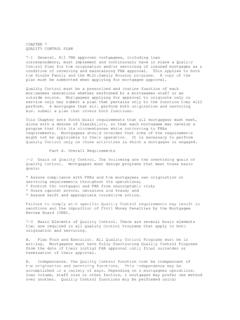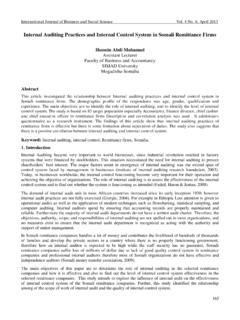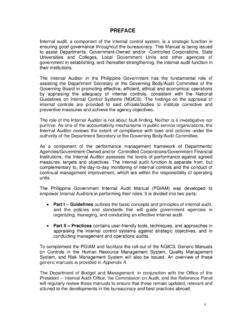Transcription of Final Pronouncement December 2020
1 Final Pronouncement December 2020. International Standard on quality Management International Standard on quality Management 1 (Previously International Standard on quality control 1). quality Management for firms that perform audits or Reviews of Financial Statements, or Other Assurance or Related Services Engagements About the IAASB. This document was developed and approved by the International Auditing and Assurance Standards Board. The objective of the IAASB is to serve the public interest by setting high- quality auditing, assurance, and other related standards and by facilitating the convergence of international and national auditing and assurance standards, thereby enhancing the quality and consistency of practice throughout the world and strengthening public confidence in the global auditing and assurance profession. The IAASB develops auditing and assurance standards and guidance for use by all professional accountants under a shared standard-setting process involving the Public Interest Oversight Board, which oversees the activities of the IAASB, and the IAASB Consultative Advisory Group, which provides public interest input into the development of the standards and guidance.
2 The structures and processes that support the operations of the IAASB are facilitated by the International Federation of Accountants (IFAC). For copyright, trademark, and permissions information, please see page 72. Page 2 of 73. ISQM 1. INTERNATIONAL STANDARD ON quality MANAGEMENT 1. quality MANAGEMENT for firms that perform audits OR. REVIEWS OF FINANCIAL STATEMENTS, OR OTHER ASSURANCE. OR RELATED SERVICES ENGAGEMENTS. (Effective as of December 15, 2022). CONTENTS. Paragraph Introduction Scope of this ISQM .. 1 5. The firm 's System of quality Management .. 6 11. Authority of this ISQM 12. Effective Date .. 13. Objective 14 15. Definitions .. 16. Requirements .. Applying, and Complying with, Relevant Requirements .. 17 18. System of quality Management .. 19 22. The firm 's Risk Assessment Process .. 23 27. Governance and Leadership .. 28. Relevant Ethical .. 29. Acceptance and Continuance of Client Relationships and Specific Engagements.
3 30. Engagement Performance .. 31. Resources .. 32. Information and Communication.. 33. Specified Responses .. 34. Monitoring and Remediation Process .. 35 47. Network Requirements or Network Services .. 48 52. Evaluating the System of quality Management .. 53 56. Documentation .. 57 60. Application and Other Explanatory Material Scope of this ISQM.. A1 A2. The firm 's System of quality Management .. A3 A5. Authority of this ISQM A6 A9. Page 3 of 73. ISQM 1. Definitions .. A10 A28. Applying, and Complying with, Relevant Requirements .. A29. System of quality Management .. A30 A38. The firm 's Risk Assessment Process .. A39 A54. Governance and Leadership .. A55 A61. Relevant Ethical .. A62 A66. Acceptance and Continuance of Client Relationships and Specific Engagements.. A67 A74. Engagement Performance .. A75 A85. Resources .. A86 A108. Information and Communication.. A109 A115. Specified Responses .. A116 A137. Monitoring and Remediation Process.
4 A138 A174. Network Requirements or Network Services .. A175 A186. Evaluating the System of quality Management .. A187 A201. Documentation .. A202 A206. International Standard on quality Management (ISQM) 1, quality Management for firms that perform audits or Reviews of Financial Statements, or Other Assurance or Related Services Engagements, should be read in conjunction with the Preface to the International quality Management, Auditing, Review, Other Assurance, and Related Services pronouncements . Page 4 of 73. ISQM 1. Introduction Scope of this ISQM. 1. This International Standard on quality Management (ISQM) deals with a firm 's responsibilities to design, implement and operate a system of quality management for audits or reviews of financial statements, or other assurance or related services engagements. 2. Engagement quality reviews form part of the firm 's system of quality management and: (a) This ISQM deals with the firm 's responsibility to establish policies or procedures addressing engagements that are required to be subject to engagement quality reviews.
5 (b) ISQM 2 1 deals with the appointment and eligibility of the engagement quality reviewer, and the performance and documentation of the engagement quality review. 3. Other pronouncements of the International Auditing and Assurance Standards Board (IAASB): (a) Are premised on the basis that the firm is subject to the ISQMs or to national requirements that are at least as demanding; 2 and (b) Include requirements for engagement partners and other engagement team members regarding quality management at the engagement level. For example, ISA 220 (Revised) deals with the specific responsibilities of the auditor regarding quality management at the engagement level for an audit of financial statements and the related responsibilities of the engagement partner. (Ref: Para. A1). 4. This ISQM is to be read in conjunction with relevant ethical requirements. Law, regulation or relevant ethical requirements may establish responsibilities for the firm 's management of quality beyond those described in this ISQM.
6 (Ref: Para. A2). 5. This ISQM applies to all firms performing audits or reviews of financial statements, or other assurance or related services engagements ( , if the firm performs any of these engagements, this ISQM. applies and the system of quality management that is established in accordance with the requirements of this ISQM enables the consistent performance by the firm of all such engagements). The firm 's System of quality Management 6. A system of quality management operates in a continual and iterative manner and is responsive to changes in the nature and circumstances of the firm and its engagements. It also does not operate in a linear manner. However, for the purposes of this ISQM, a system of quality management addresses the following eight components: (Ref: Para. A3). (a) The firm 's risk assessment process;. (b) Governance and leadership;. (c) Relevant ethical requirements;. (d) Acceptance and continuance of client relationships and specific engagements.
7 (e) Engagement performance;. 1. ISQM 2, Engagement quality Reviews 2. See, for example, International Standard on Auditing (ISA) 220 (Revised), quality Management for an audit of Financial Statements (Revised), paragraph 3. Page 5 of 73. ISQM 1. (f) Resources;. (g) Information and communication; and (h) The monitoring and remediation process. 7. This ISQM requires the firm to apply a risk-based approach in designing, implementing and operating the components of the system of quality management in an interconnected and coordinated manner such that the firm proactively manages the quality of engagements performed by the firm . (Ref: Para. A4). 8. The risk-based approach is embedded in the requirements of this ISQM through: (a) Establishing quality objectives. The quality objectives established by the firm consist of objectives in relation to the components of the system of quality management that are to be achieved by the firm .
8 The firm is required to establish the quality objectives specified by this ISQM and any additional quality objectives considered necessary by the firm to achieve the objectives of the system of quality management. (b) Identifying and assessing risks to the achievement of the quality objectives (referred to in this standard as quality risks). The firm is required to identify and assess quality risks to provide a basis for the design and implementation of responses. (c) Designing and implementing responses to address the quality risks. The nature, timing and extent of the firm 's responses to address the quality risks are based on and are responsive to the reasons for the assessments given to the quality risks. 9. This ISQM requires that , at least annually, the individual(s) assigned ultimate responsibility and accountability for the system of quality management, on behalf of the firm , evaluates the system of quality management and concludes whether the system of quality management provides the firm with reasonable assurance that the objectives of the system, stated in paragraph 14(a) and (b), are being achieved.
9 (Ref: Para. A5). Scalability 10. In applying a risk-based approach, the firm is required to take into account: (a) The nature and circumstances of the firm ; and (b) The nature and circumstances of the engagements performed by the firm . Accordingly, the design of the firm 's system of quality management, in particular the complexity and formality of the system, will vary. For example, a firm that performs different types of engagements for a wide variety of entities, including audits of financial statements of listed entities, will likely need to have a more complex and formalized system of quality management and supporting documentation, than a firm that performs only reviews of financial statements or compilation engagements. Networks and Service Providers 11. This ISQM addresses the firm 's responsibilities when the firm : (a) Belongs to a network, and the firm complies with network requirements or uses network services in the system of quality management or in the performance of engagements; or Page 6 of 73.
10 ISQM 1. (b) Uses resources from a service provider in the system of quality management or in the performance of engagements. Even when the firm complies with network requirements or uses network services or resources from a service provider, the firm is responsible for its system of quality management. Authority of this ISQM. 12. Paragraph 14 contains the objective of the firm in following this ISQM. This ISQM contains: (Ref: Para. A6). (a) Requirements designed to enable the firm to meet the objective in paragraph 14; (Ref: Para. A7). (b) Related guidance in the form of application and other explanatory material; (Ref: Para. A8). (c) Introductory material that provides context relevant to a proper understanding of this ISQM;. and (d) Definitions. (Ref: Para. A9). Effective Date 13. Systems of quality management in compliance with this ISQM are required to be designed and implemented by December 15, 2022, and the evaluation of the system of quality management required by paragraphs 53 54 of this ISQM is required to be performed within one year following December 15, 2022.
